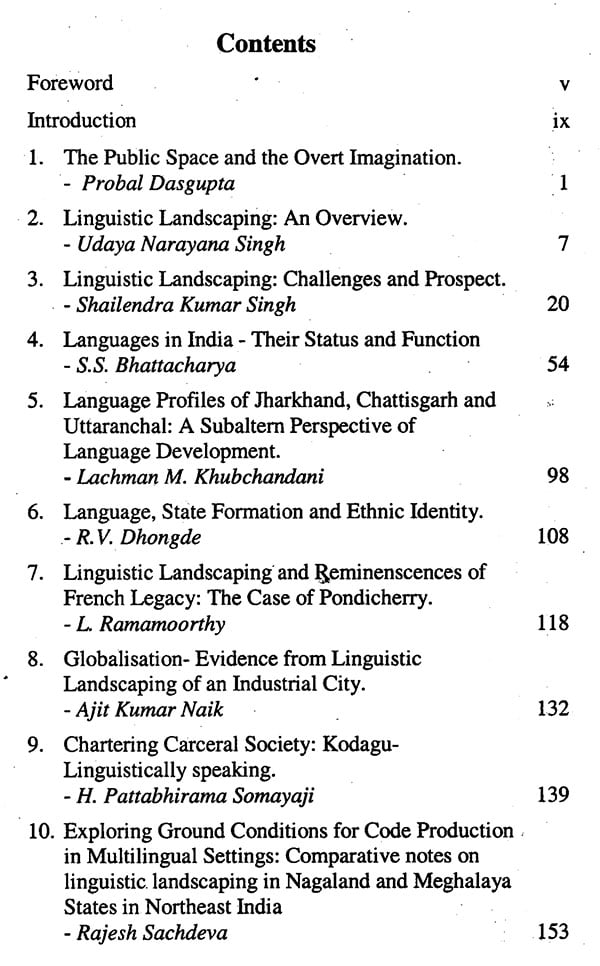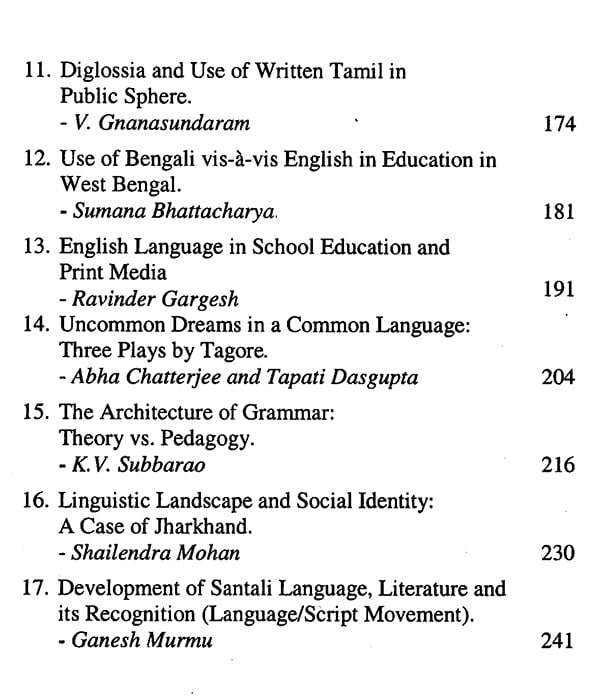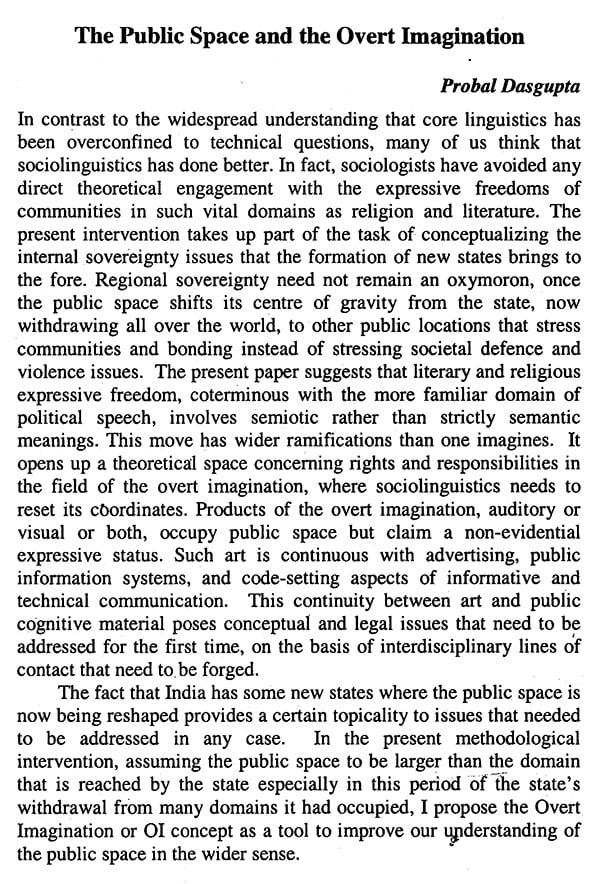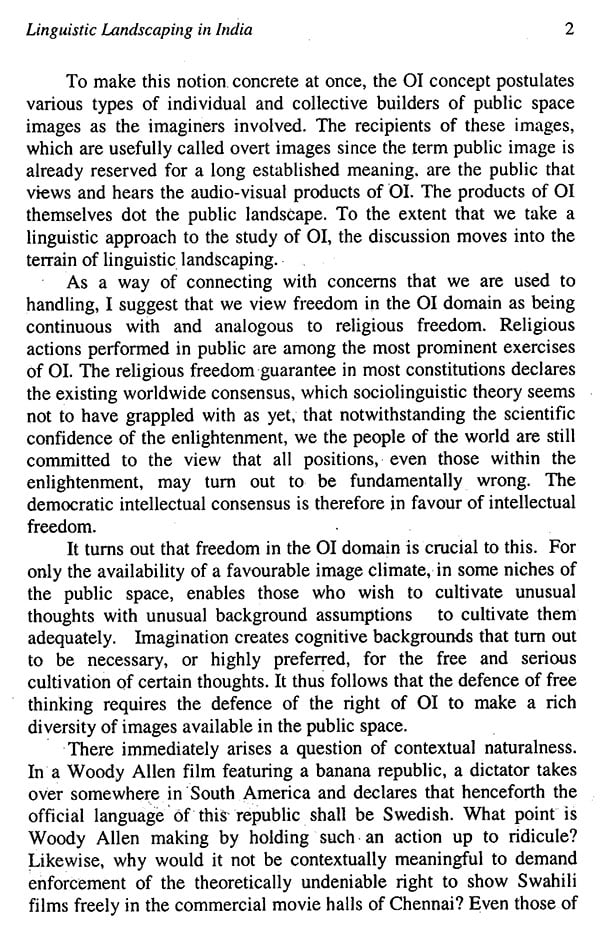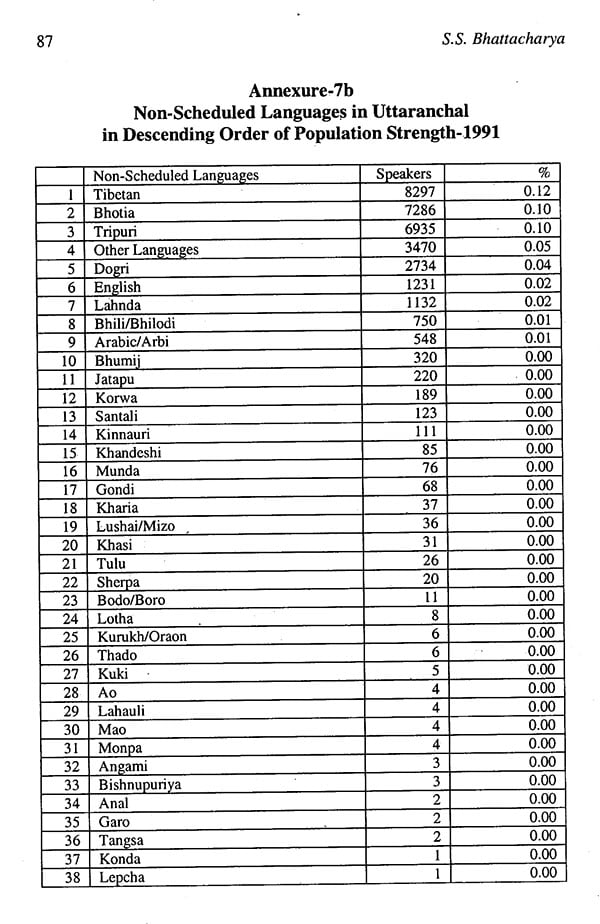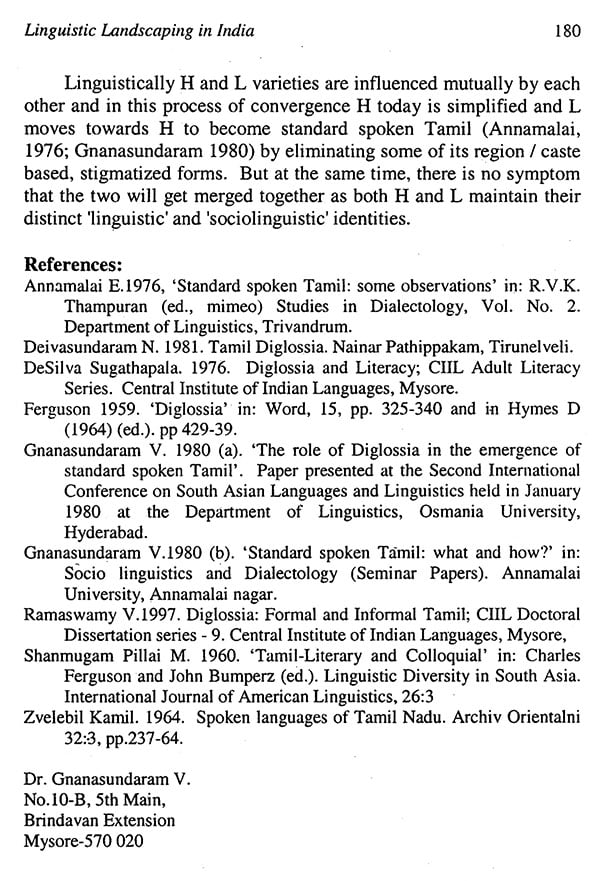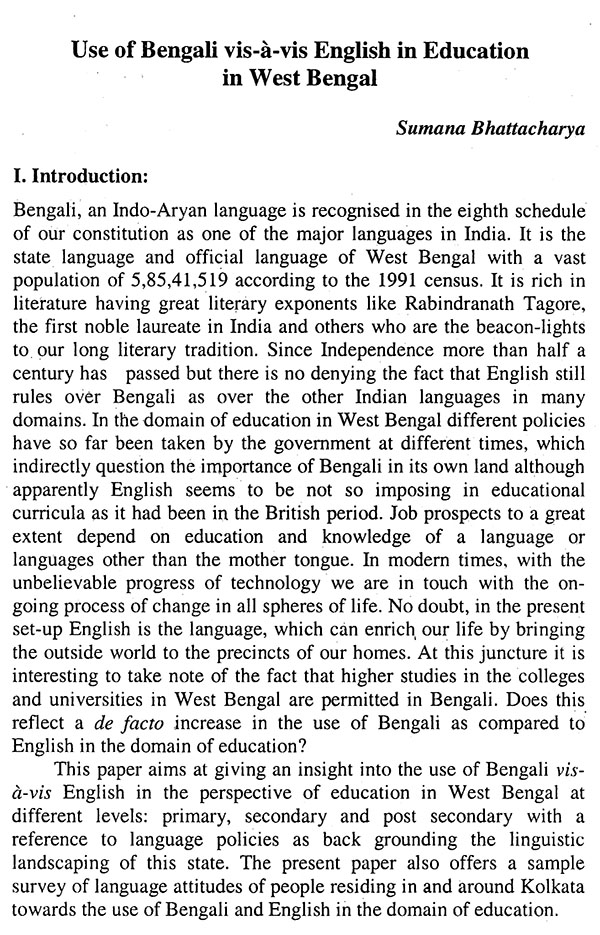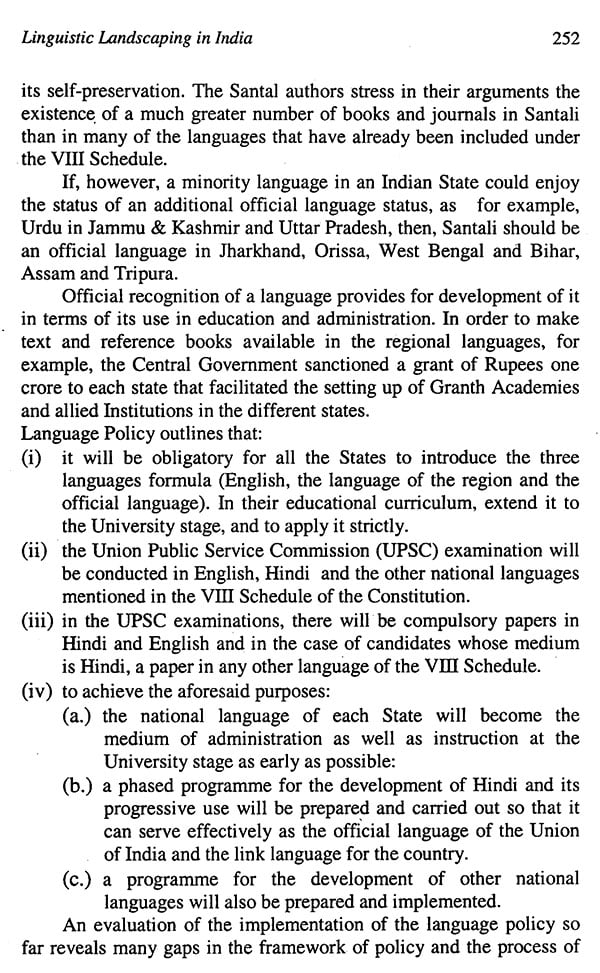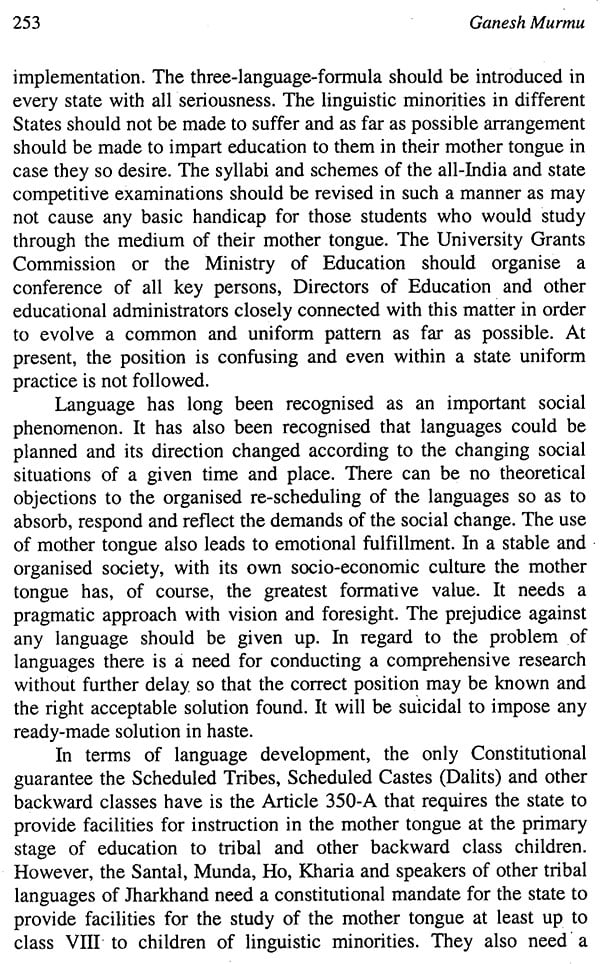
Linguistic Landscaping in India with Particular Reference to the New States
Book Specification
| Item Code: | NAX325 |
| Author: | N.H. Itagi and Shailendra Kumar Singh |
| Publisher: | Central Institute Of Indian Languages, Mysore |
| Language: | English |
| Edition: | 2002 |
| ISBN: | 8173420998 |
| Pages: | 256 |
| Cover: | PAPERBACK |
| Other Details | 9.00 X 6.00 inch |
| Weight | 350 gm |
Book Description
Imagine the challenge before a landscaping specialist to raze a completely urban habitat on ground, and create, instead, a prototype village in its place. This will surely be a nightmare for the specialist because all landscaping specialists and software such as SiteManagers or KnowledgePath from Athenic Systems (or TreeGuide Inc.), AutoCAD-based Pro-Landscaping Landscape Software or its earlier version — EZ-Plant Software of David Petrosky, Greenhouse Irrigation Control Software from Eldar Shany and Phytech Limited or LM 2002 Pro Plus from Alocet, etc. only talk about management of our cityscape, or at best, how green must our effort be to alter our urban landscape. If tomorrow’s spatial management requirements demand bucolic landscaping, landscapers would surely try to meet such challenges too. But they are neither ready with a possible taxonomy nor with a theory or methodology of creating a village out of a city. Creating a village out of a village, or one out of nothing is fine. But ever heard of a clock that moved from right to left?
Although natural landscaping technicians will not be able to give you a theory or a methodology other than what they have been doing, a Linguistic Landscaping specialist has this extra-ordinary challenge to meet in order to create a design to suit the need, desire, dreams and reality. Need refers to socio-political needs; desire is that of its common speakers who are to meet new challenges; dream is that of the language elite to see their language on the center-stage somewhere; and reality is reality. Cut your plan according to your answers to these four-fold parameters. It could be that a relatively underdeveloped language community is in a hurry to not only bring in standardization to its language but also to modernize it by expanding its functional spread (on radio and television, or in school as a medium of instruction, or in law courts as a valid legal language). It was also perfectly possible that a highly standardized language with a ‘wooden’ structure and with a world of stiffness that comes from a long history of stilted growth wants to take help of a LL expert in order to bring in vibrancy and diversity in its expression system and create major changes in its stylistic options. Thus, as one could see in case of Linguistic landscaping, one could make a movement in both directions. A theory of LL should be able to live up to all such theoretical possibilities and practical requirements.
What began as a purely academic exercise during the third ICOSAL Conference at Hyderabad especially due to an Indo-Israeli contact during its post-Congress session emerged as a full-fledged event thanks to untiring effort of scholars from two institutions listed here under the credits page, and the galaxy of scholars who participated in the event went back with as much new thoughts as they contributed at Mysore during a few eventful days. It is an effort that has been fructified through this volume — which could have been surely bigger and better, or more comprehensive than what we see here. But we thought the community of scholars in India and abroad who are not so much aware of the developments in this new line of research must be exposed to the ongoing thought of Indian linguists in an inter-disciplinary area.
On my behalf and on behalf of Mahatma Gandhi International Hindi University, we are happy to dedicate this volume to the community of scholars and practitioners of numerous languages of India. I recall an incident from a celebrated Bengali novel of Sunil Gangopadhyay where the hero — quite innocent and oblivious of the environmental concerns - was quite ecstatic about the fact he learnt in the uneven terrains of the borders of Bihar and Bengal that hills and hillocks were on sale for as low a price as Rs. 50 as there was none to care for the landscape of this shy and undeveloped land masses. The hero thought how nice it would have been to buy one of those for this affordable price and do his own landscaping to live on it. I find such wishes often being expressed by a tribal youth (who may otherwise be devoted to the magic that his language offers) about his own language or about his neighbour’s. They often remain as wishes throughout their lifetime and even turn into lamentations, and they would be so unless LL steps in to alter the face of our public spaces. We are sure the volume will generate interest, heat, comments, criticism, discussion, and debate among those for whom it is meant. We will wait for these reactions anxiously. As for me, I still wish I could have one of these hills.
Linguistic Landscape/Landscaping (LL) as language use in its written form (visible language) in the public sphere or as referring "to all linguistic objects which mark the public arena" (Landry and Bourhis 1997, Ben-Rafael and Shohamy 1998), is shaped by the individuals, institutions and the State by their choice of language/s within a given language ecology in the context of the processes such as globalization, sanskritisation, nativisation, etc. and language policies of the State. Linguistic landscaping by different agencies may be marked by conflict or concordance. Linguistic Landscaping serves not merely the communication of information function but also several other symbolic functions such as assertion of ethno-linguistic identities, responses to language policies and discourse and power structures embedded in language use.
The domains of linguistic landscaping are secular and religious, commercial and non-commercial. Education, administration and mass communication, commerce and industry and services are the broad public areas linguistically landscaped. The sites of linguistic landscaping range from textual material-literary and non-literary, including translations, news papers and periodicals, advertisements, naming of the States, places, localities, streets and traffic islands, name plates of homes, private and public offices, invitation cards, visiting cards, to graffiti (writing on the wall). A study of these as signs of social signification would help understand the social dynamics and formulate the policies and programmes by the State.
The reorganization of Indian States after independence on linguistic basis was a great act towards linguistic landscaping of the country. Owing to regional imbalances in development coupled with inefficiencies in our linguistic landscaping as an integral part of socio-economic development, the demand for new States grew, first on the basis of cultural autonomy as in the northeast and then on the basis of development or lack of it as in the new sub-States of the heartland. These States, though not formed on the basis of language and not preceded by strong language movements, have, nevertheless, to face the challenge of linguistic landscaping of their regions. The task of linguistic landscaping in the new States is all the more challenging because of several significant subaltern groups with languages without writing systems, script movements, written tradition, low levels of literacy and development, etc. Socio- linguistic identity as an essential component of development process is increasingly getting reflected in the efforts at redefining the geo- political space.
It is in this context that the Geolinguistics Group of the Central Institute of Indian Languages in collaboration with the Mahatma Gandhi International Hindi University organized a two-day seminar on Linguistic Landscaping in India with particular reference to the new States on 21 and 22" February 2002 at the Institute in Mysore. The present volume is a collection of revised select articles presented in the Seminar.
The variegated nature of the articles shows how different scholars view this new field even at the conceptual level. The papers by Probal Dasgupta, Udaya Narayana Singh and Shailendra Kumar Singh deal with the conceptual aspects of Linguistic Landscaping; that of Dasgupta providing a theoretical perspective of, and anchorage to the field, of Udaya Narayana taking a language planning/language engineering perspective of the field within a possible theory of LL towards which he makes some propositions, and of Shailendra Kumar providing a conceptual and operational schema for linguistic landscaping and its study in the Indian context. Intrinsic to Dasgupta’s proposition as given in his paper and also in his valedictory address to the seminar is that linguistic landscaping is an intentional designed/planned artistic activity of the overt imagination that presupposes freedom and allows for synergy which can not be planned and continuous negotiation with ones plan in view of the unknown designs of the others as they unfold. Udaya Narayana on the other hand makes propositions towards a theory of linguistic landscaping as organized scientific interventions into a language in the form of language planning or language engineering which add to the ‘functionality’, ‘a storage system’ to the "frame" of a language and. "links" it up with other socio-spatial and virtual systems and networks. The remaining papers by and large could be seen as operational interpolations between the two theoretical propositions, not entirely mutually exclusive, of linguistic landscaping outlined in these first two papers. The two papers by Bhattacharya and Khubchandani provide the essential language profiles of the country and of the new States. The articles of Dhongde, Ramamoorthy and Ajit Naik are closer to linguistic landscaping as dealt with by Landry and Bourhis, Ben-Rafael and Elana Shohamy, Bernard Spolsky, and others. Somayaji’s paper historicizes the noticeable and engineered cultural and linguistic formations to which most of the dominant expressions of today are traceable in a carceral society. The succeeding papers of Sachdeva, Gnanasundaram, Sumana, and Gargesh deal with linguistic landscaping as an extended phenomenon of language use dealt with within Sociolinguistics. Abha and Tapati deal with language use in literature as practiced by Tagore as a linguistic landscape architect in his plays and Subbarao views grammatical description of language(s) as linguistic landscaping. The two papers by Shailendra Mohan and Ganesh Murmu deal with social and linguistic identities and language use and/as_ linguistic landscaping in the new State of Jharkhand and validate the observation of Khubchandani that the languages of the subaltern are for identity and communication while the regional or supra regional major languages like Hindi and English are for "language display" and linguistic landscaping.
